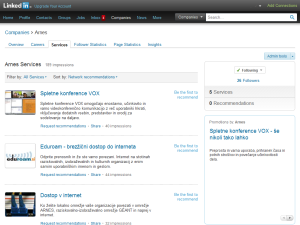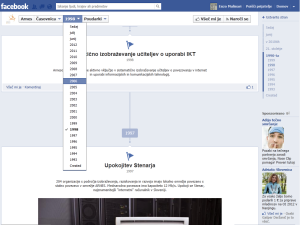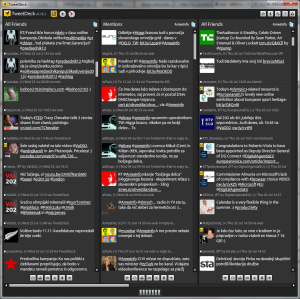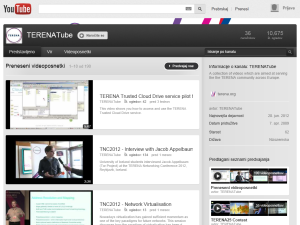Author: Domen Božeglav, ARNES, <domen.bozeglav@arnes.si>
Review: Laura Durnford, TERENA, <durnford@terena.org>, Gitte Julin Kudsk, <gitte.kudsk@uni-c.dk>
Introduction
The goal of Social Media Jumpstart pack is to help NRENs start their own Social Media presence or improve existing one. The document aims at PR (or other) coordinators setting up the NREN Social Media whereas some parts aimed at end users producing content - e. g. technical staff. It's not an overwhelming strategy but rather how to directions you can use instantly.
The structure of the document is divided into 7 logical steps which imitate the natural top to bottom deployment of NREN Social Media presence (some steps of deployment are further covered in detail on TERENA wiki space):
- Why do you need it
- Which Social Media are you talking about
- Evaluet ROI
- Get the Management buy
- Deployment
- Start producing content and engage coworkers
- Measuring
The document was created by TF-CPR but all TERENA employees are kindly invited to contribute to the subsections of the document. It's also constant work in progress so expect updates as Social Media matures.
1. Answer the question “Why do your NREN need social media
The most common reason for expanding our PR efforts to Social Media is "because others are on social media too". In our opinion this argument is wrong and if you don't exactly know, what to do with social media, better don't bother putting efforts into it.
- Write down what you expect form social media
- What’s your audience
- How do you plan to talk to your audience (in comparison to other channel)
- What do you consider as a success?
Before going any further, try to honestly answer this two questions:
- Are you and your organisation ready to communicate on the new channels?
- Who are going te be communicating and are they prepared to take enough time to do that?
If you can't answer above questions, feel free to explore the subject a bit further:
- How to Introduce Social Media to Your Business: when to and when not to expand your channels to Social Media
- Develop a Social Media Strategy in 7 Steps: how not to loose focus when deploying Social Media
- Understanding the Experience of Social Network Sites: don't just follow others. Understand what you are doing in WHY you are doing it.
2. Decide which social media you are going to adapt
The Social Media space is changing as we speak - some applications cease to exist and some new emerge all the time. Though we are aware of some serious players that won't vanish through the night (e. g. Facebook, Twitter, LinkedIn, Youtube ...). If you want to maintain the focus and momentum we suggest you decide on Social Media applications you are going to adopt.
For now NRENs are present on (in the app, order of frequency):
- Youtube
- Google+
- Blogspot
- Wikipedia
- Custom Social Media deployments and various blogs
For details an live examples check the NREN Social Media presence wiki page, where you can explore how NRENs have set their Social Media presence
If you can't decide on which Social Media to adopt additional hints can be found at:
- Market analysis of social network platforms and their developments: the list hasn't been updated for a while but it still serves as a reference or pointer to more up to date information
- Social networking sites and our lives: which Social Media we use
- Social media Examiner: use cases of various Social Media application uses
3. Evaluate ROI and decide if it's worth the effort
If by now you still aren't sure what you'd like to achieve with Social Media channels it will be very hard to evaluate the ROI (Return on Investment). Try thinking at least in these areas:
- With publishing on Social Media channels you will reach broader audience.
- You will be able to reach people that usually don't monitor your web page for news feeds.
- News editors and some decision makers are very active on Social Media. It's much easier to reach them now (Twitter)
- You can get instant feedbacks on things you publish
- People are able to react on your publishment
- Social Media is a great place to launch less formal news
- Consistent Social Media presence can bring you higher brand awareness
Social Media requires constant involvement so don't underestimate the work you will have to invest to start Social media and keep it going. Here are a few hints from our own experience
- Deployment takes time. It can take from a single day to even a month or more if you want to exploit the full potential of applications (e. g. Facebook games, apps ...)
- Social Media constantly evolves so you will likely have to invest some more time as new feature are available
- Content publishing on the Social Media is trivial but you will have to "tune in" the news a bit to get better results. Avoid the use of RSS refeeds on Social Media at all costs
- You'll have to take time to monitor what's going on and potentially answer addition questions from users, though tools that make that easier for you are freely available on the Internet (e. g. netwibes)
- Eventually you'll probably have to face "difficult users". Such appearances are rare but can take a lot of time and effort to solve.
- If possible have a person responsible for looking after Social Media in your team ...
So now, do the math. Also think about hiring a professional to do it for you. There are more and more firms also aware of NGOs (Non-governmental organisations) specifics e. g. Helpful Technology that led TF-CPR Social Media workshop.
4. Make the final decision and get a management “buy in”.
With Social Media in place at some stage you will definitely need management support so now is the last time to get their consent for the project. Since the management is on your side now it's an excellent opportunity to push forward Company Social Media policy.
Though some NGOs are often keen on creating very long polices, we suggest you take the UK Govermnment Social media guidance for civil servants as an example:
Government expects civil servants to adhere to the Civil Service Code online as well as offline.
Do check this additional "light" examples of policy and guidelines:
- NPR's guidelines for using social netowrks will show you how journalists should use the Social Media
- The USA AirForce - Armed with social media will prove there are more strict organizations than your NREN with much "slimmer" Social Media policy.
But if you need a more elaborate Social Media policy Social media policy examples Wiki page offers you a few NREN and a lot of corporate extensive examples.
5. Start deploying your social media
When deploying various Social Media applications there are some general guidelines you can follow:
- Learn from others. Be active and see for yourself what's working and what's not. Check NREN Social Media presence Wiki page for ideas.
- You won't be able to monitor entire Social Media space. Plan deploying various tools like netwibes to save you time once your applications will be in production.
- Technology and applications are changing all the time. Instead of training employees for specific applications think it more general terms and give them "How to communicate on Social Media" like courses that will keep value even when you are migrating from e. g. Facebook to Pinterest.
- With very limited resources for Social Media you won't likely have a chance to be innovative with social media. Learn from others if the knowledge is available - e. g. Do's and Don'ts of Social Media.
Facebook has the highest number of users so it's probably the best "usual suspect" to start with.
- Create you NREN page profile (don’t use groups since they will be depreciated and don’t create a personal profile for your company since it’s against the FB rules).
- Add company data, try to “talk to people” don’t just use facts.
- Use new layout mode with cover photo. We are visual beings and also Social Media is a lot about visual things.
- Publish as much photos as you can - people will most likely check them out and engage on them.
- Use the new Timeline feature and create your NREN history a bit more fun.
- Notify your colleagues about the new page and hopefully they will like it (and others will follow them).
If you plan on spending further efforts on Facebook consider reading
- 13 Hot Facebook Marketing Tips From the Top Pros is a mock-up of advices from Social Media experts
- Involver will help you with advices on how to integrate various applications in Facebook
- And you can always rely on All Facebook, unofficial and Facebook pages - official Facebook cookbook.
Twitter is often called Social Network for intellectuals, so it's quite likely you will be able to reach important journalists and decision makers there. You can set up your profile in minutes and in terms of customization adding a logo and a simple background picture resembling your common design should be no brainer:
- Once you create your corporate profile do take time to customize it. It will make all the difference if someone lands on your profile.
- Make sure you state who stands behind company Twitter profile - name the person(s), so users know who they are talking to.
- Twitter users produce a lot of post so make sure you install the desktop or mobile tools. They will help you navigate through the information noise and manage multiple accounts and hash-tags. There are many solutions though for Windows and iOS desktops we would suggest Tweetdeck, and for Android "Tweetdeck" or "Twitter" application.
- Don't forget to set automatic notifications for various events - for instance when somebody mentions you or reposts one of your tweets.
- Since twitting is so dynamic make sure you stay connected to emerging trends on Twitter: Twitip.
LinkedIn could also be called the Facebook for professionals. Especially professionals from technical fields are present and try to "connect" on LinkedIn. In my experience a vast number of NREN employees is already present on LinkedIn though the activity rarely exceeds the linking with others. Company LinkedIn profile is also good for raising brand awareness.
- When creating a company profile try to search for and "link" existing company (your company could be already listed among companies and linked to your employees).
- Add the company "professional" data. Think of the profile as a billboard for job seekers.
- In this case think about incorporating company news RSS. LinkedIn is not (jet) as live as other Social Networks so it could save you some time and the damage is not sa big as using RSS on Facebook or twitter.
- Add a few most important services you offer and are important to you.
- If you are looking for new employees all the time, fill in the Job section.
- Check the LinkedIn official guidelines for additional possibilities you can apply on your LinkedIn profile.
Youtube
People rarely browse through custom Youtube channels though creating one brings credibility and raises brand awareness. In contrary to majority of NREN custom solutions it offers additional customization and subscriptions.
- When creating your channel think about the namecarefully since it will tend to (or not) pop up at the searches.
- Add the info about the channel. Careful use of words applies in this case too.
- Creating a customized, NREN branded background and slight channelcustomization is trivial
- Select featured channels and upload so many videos that the channel at least looks fool if you blindly land on it.
Wikipedia
The Wikipedia page about your NREN is probably already online and it was created by Wikipedia enthusiast. In any case you will have to be careful when editing or adding the information since local Wikipedia users look after ther Wikipedia spaces passionately.
- Check whether your NREN is already on Wikipedia and whether the information about your NREN is up to date.
- If you have to update the information, be aware of strict editorial policy and comply to it.
- If possible, try contacting "local Wikipedia caretaker" and discuss what you should add or update.
Google+, Pinterest, Flikr, Instagram, various Blogs, Wikispaces and future Social Media applications
With so many Social Media applications it's really hard to know where to put your focus. If the application is not in your immediate interest you certainly shouldn't be spending too much time on it. We suggest you do the following:
- Register your company account as soon as possible so you can "reserve" your Brand username.
- Keep the username and password somewhere safe if you decide to work further in the future.
- If possible also add short company description and company logo.
- Wait what happens with the application.
- And be aware. With some of them you will need an android or apple based mobile device.
In my opinion Instagram will be the next Social Media application worth spending efforts on.
6. Start producing content and engage coworkers
Once you are set on the boat your work really begins. If you want results it takes your time effort and constant involvement! Here are some general guidelines that will keep you going in the right direction:
- Understand what you are doing. All Social Media applications have their own rules and you have to understand them to use them effectively.
- Invite your work colleagues and technicians to participate in your Social Media channels.
- Make it clear that everyone in the company should be aware of and follow your social media guidelines and policy.
- Answer the questions as soon as possible to maintain you credibility.
- Always make people feel that their opinion matters.
- And most important: If you have nothing to say, don’t say it!
- Don't forget checking the trends all the time. You could be waisting your precious time on Social Media application that are "so last year"!
- Show people you appreciate their time. They will reward it.
- Facebook users love photos and stories. Add as many photos as possible.
- Create NREN events of Facebook and invite people to participate. That's certainly a new channel to reach them.
- Photograph events and post photos from events on your profile. It will bring the traffic to your site all by itself.
- When you launch a new service use Facebook to share some extras with your users or give them some previews in advance - they will appreciate it. It's also a good way for getting frank feedback.
- Create contests if you would like to activate your users or gain new ones.
- Advertise to friends of your followers. It's very inexpensive and you can target specific users with little effort.
- Monitor what your users like and repeat it multiple times.
- Don't forget twitter can use a lot of your time if you get involved! Try to build it in your every day work-flow but do be conservative!
- Always twitt in #twitter language, otherwise @community will think you #failed. So learn it before twitting!
- Start following journalists and people of the same interest
- Whenever possible try to twitt breaking news
- Be polite, give credit. If you saw an interesting twitt, don'd twitt it as your own. Use Re-twitt!
- Observe when people you would like to reach hang on Twitter. Twitt your news when they are online.
- Use tools to help you manage the twitts. Do you remember the IRC? Twitter is just like IRC but with fancier interface.
- Reply to twits - engage in conversation.
- To promote your twitter @account, event #hashtag or engage users, use twittwals on events. It will help you display event related twitts in real time on television or an extra projector.
- If you are in the search of new employees, make sure your job billboard on LinkeIn is up to date.
- Engage in conversations in professional groups to let them know you are here.
Youtube
- Keep an eye on the comments on movies you published. It's possible you'll have to give additional information or catch a chance to get a new user.
Wikipedia
- Just make sure the information on the Wikipedia is up to date and accurate, "Wikipedia caretakers" will take care for all the rest.
Google+, Pinterest, Flikr, Instagram, various Blogs, Wikispaces and future Social Media applications
- Keep an eye on all these networks and act accordingly. Make sure you are able to spot emerging applications too.
- If you notice a lot of users has started using Instagram, plan your future efforts into deploying and using this application in the future.
- Even if you think some Social Media applications are just toys it's quite possible you just don't know how to use them. So explore!
7. Measure success and report back to management
Deploying and using Social Media is often quite rewarding since it's very easy to measure the impact of your efforts. Each Social Media application usually has it's own insights tool which will show you when and how users react on your posts. These insights are very useful so make sure you check them frequently and even more important, act on them accordingly.
Though insights will give you the best information you can always:
- Count the number of your followers, likes and retwitts.
- Monitor news dissemination through social media. If possible monitor your CMS for different entry points to your news articles.
- Use tools for accessing influence (e. g. klout, peerindex).
Don't forget to let management know you are doing a good job. Show them insights, show them how your news are spreading, how your influence is spreading. It will be easier for them to grant you new resources if you have something to show. And don't forget to mention: in recession times Social Media takes more of your time and less of organization's money whilst producing very good results when managed in the right way.






